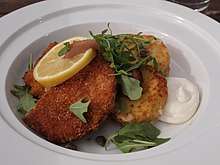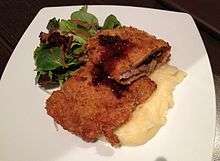Wiener schnitzel

Wiener schnitzel (/ˈviːnər
It is one of the best known specialities of Viennese cuisine, and one of the national dishes of Austria.[2][3]
History and etymology
.jpg)
The designation Wiener Schnitzel first appeared in the 19th century, with the first known mention in a cookbook from 1831.[4] In the popular southern German cookbook by Katharina Prato, it was mentioned as eingebröselte Kalbsschnitzchen (roughly translated: crusted veal cutlets).[5]
According to a tale, field marshal Joseph Radetzky von Radetz brought the recipe from Italy to Vienna in 1857. In 2007, linguist Heinz Dieter Pohl discovered that this story had been invented.[6] According to Pohl, the dish is first mentioned in connection with Radetzky in 1869 in an Italian gastronomy book (Guida gastronomica d'Italia), which was published in German in 1871 as Italien tafelt, and it is claimed that the story instead concerned the cotoletta alla milanese. Before this time, the story was unknown in Austria. The Radetzky legend is however based on this book, which claims that a Count Attems, an adjutant to the emperor Franz Joseph I of Austria gave a notice from Radetzky about the situation in Lombardy and mentioned a tasty veal steak in a margin note. After Radetzky had returned, the emperor personally requested the recipe from him.[5]
Pohl relates this anecdote with the words: "This story is scientifically meaningless, it does not cite any sources and it is not mentioned […] in the literature about Radetzky. No such Count Attems appears in any biographical work about the Austrian monarchy, which would have corresponded to this time and position."[5]
Pohl doubts that Wiener schnitzel came from Italy at all, with the basis that in the other "imported dishes" in Austrian cuisine, the original concept is mentioned, even if in Germanised form, such as in goulash or pancakes, and the schnitzel does not appear even in specialised cookbooks about Italian cuisine.[7]
Pohl hints that there had been other dishes in Austrian cuisine, before the Schnitzel, that were breaded and deep fried, such as the popular Backhendl, which was first mentioned in a cookbook from 1719. The Schnitzel was then mentioned in the 19th century as Wiener Schnitzel analogically to the Wiener Backhendl.[5]
Documents in the Milan archive of Saint Ambrose dated 1148 use the Latin name lumbolos cum panitio,[8] which can be translated as "little chops with breadcrumbs". This can be a hint that a dish similar to the cotoletta alla milanese already existed at that time.
In 1887, E. F. Knight wrote of a Wienerschnitzel ordered in a Rotterdam cafe, "as far as I could make out, the lowest layer of a Wienerschnitzel consists of juicy veal steaks and slices of lemon peel; the next layer is composed of sardines; then come sliced gherkins, capers, and diverse mysteries; a delicate sauce flavours the whole, and the result is a gastronomic dream."[9]
Preparation

The dish is prepared from veal slices, butterfly cut, about 4 millimetres (0.16 in) thin and lightly pounded flat, slightly salted, and rolled in flour, whipped eggs and bread crumbs. The bread crumbs must not be pressed into the meat, so that they stay dry and can be "souffléd". Finally the Schnitzel is fried in a good proportion of lard or clarified butter at a temperature from 160 to 170 °C[11] until it is golden yellow. The Schnitzel must swim in the fat, otherwise it will not cook evenly: the fat cools too much and intrudes into the bread crumbs, moistening them. During the frying the Schnitzel is repeatedly slightly tossed around the pan. Also during the frying, fat can be scooped from the pan with a spoon and poured onto the meat. The Schnitzel is cooked after it turns golden yellow or brown.[12]
The dish is traditionally served in Austria with Kopfsalat (lettuce tossed with a sweetened vinaigrette dressing, optionally with chopped chives or onions), potato salad, cucumber salad, or parsley potatoes. Currently it is also served with rice, french fries or roasted potatoes. It is common to serve it with a slice of lemon, to give the bread crumbs more taste, and a sprig of parsley. "It has however become common in Northern Germany to serve it with lemon, cucumber slices, sardines and capers, to achieve a pleasant appearance".[13]
Similar dishes

A popular variation is made with pork instead of veal, because pork is cheaper than veal (usually about half the price). To avoid mixing up different products, the Austrian and German food committees have decided that a "Wiener Schnitzel" must be made of veal. A Schnitzel made of pork can be called "Schnitzel Wiener Art" (Viennese style schnitzel) or "Wiener Schnitzel vom Schwein" (Viennese schnitzel from pork). The Verwaltungsgericht Arnsberg 2009 decided about the acceptability of the latter name. The result was that in common parlance in Germany, a "Wiener Schnitzel" no more referred exclusively to a veal dish, but instead to a breaded steak in general.[14]
Similar dishes to Wiener schnitzel include Surschnitzel (from cured meat), and breaded turkey or chicken steaks. Similarly prepared dishes include cotoletta alla milanese, schnitzel cordon bleu filled with ham and cheese[15] and Pariser Schnitzel. The American chicken-fried steak is often said to be closely related to Wiener schnitzel, the result of the adaptation of the recipe by German or Austrian immigrants to the Texas Hill Country to locally available ingredients.[16]
Tonkatsu is a similar, fried pork cutlet from Japanese cuisine, is thicker than its European counterparts and widespread in Japan and South Korea.
In the Southern Cone, particularly in Argentina and Uruguay, a similar dish is milanesa, often served with french fries or mashed potatoes.
In Israel, Schnitzel is one of the most popular dishes served. It was first introduced by European Jews who immigrated to Israel during the mid-1900’s. Due to food shortage at that time and the high cost of meat and veal, the local version was made of chicken breast which was relatively inexpensive. Till this day, the Israeli Schnitzel is made of chicken.
See also
References
- ↑ Bickel, Hans; Landolt, Christoph (2012). Duden - Schweizerhochdeutsch : Wörterbuch der Standardsprache in der deutschen Schweiz (in German). Mannheim: Dudenverlag. p. 85. ISBN 9783411902682.
- ↑ "Wiener Schnitzel – Austria's National Food". All Things Austria. 13 December 2010. Retrieved 27 March 2014.
- ↑ "Wiener Schnitzel". Hunter Angler Gardener Cook. 21 December 2012. Retrieved 27 March 2014.
- ↑ Neudecker, Maria Anna (1831). Allerneuestes allgemeines Kochbuch. Prague.
- 1 2 3 4 Pohl, Heinz Dieter (2007). Die österreichische Küchensprache. Ein Lexikon der typisch österreichischen kulinarischen Besonderheiten (mit sprachwissenschaftlichen Erläuterungen) (in German). Vienna: Praesens-Verlag. pp. 154–155. ISBN 3-7069-0452-7.
- ↑ "Rund ums Wiener Schnitzel – ein Beitrag zur Sach- und Wortgeschichte" (PDF). Heinz Pohl Personal Homepage (in German). Retrieved 18 April 2017.
- ↑ Pohl, Heinz Dieter: Zur bairisch-österreichischen Küchensprache (PDF)
- ↑ "The History of Wiener Schnitzel". kitchenproject.com. Retrieved 27 March 2014.
- ↑ Knight, E. F. (1888). The "Falcon" On the Baltic: A Coasting Voyage From Hammersmith to Copenhagen in a Three-Ton Yacht. p. 76.
- ↑ Snellman.fi: Wieninleike resepit ja ohje (in Finnish): Ja muualla kuin Itävallassa, saa wieninleike usein seurakseen myös anjovista ja kapriksia, josta muodostuukin kerrassaan herkullinen yhdistelmä! ("And outside Austria, the Wiener schnitzel is often accompanied by anchovy and capers which make a delicious combination!")
- ↑ "Nur mal so: Wiener Schnitzel ist Kalbfleisch, kein Schnitzel aus dem Toaster" (in German). Focus.de. 10 January 2008. Retrieved 27 March 2014.
- ↑ "Wiener Schnitzel – Tips for Preparing a Wiener Schnitzel". German Food Guide. Retrieved 27 March 2014.
- ↑ Banzer, M.C./Friebel, Carl: Die Hotel- und Restaurationskücke, 3rd edition, Gießen 1950, p. 160
- ↑ Urteil: Schweineschnitzel darf weiterhin "Wiener Schnitzel vom Schwein" heißen, 10 November 2009, accessed on 4 February 2011
- ↑ Cordon bleu, Verein Kulinarisches Erbe der Schweiz. Accessed on 27 December 2008.
- ↑ Weaver, Bobby. "Chicken-Fried Steak". Oklahoma Encyclopedia of History and Culture. Oklahoma Historical Society. Retrieved January 27, 2010.
Further reading
- Haslinger, Ingrid: Entwicklungsstationen einiger typischer Gerichte der Wiener Küche. In: Dannielczyk, Julia; Wasner-Peter, Isabella (ed.): "Heut' muß der Tisch sich völlig bieg'n". Wiener Küche und ihre Kochbücher, Mandelbaum-Verlag, vienna 2007, ISBN 978-3-85476-246-1, pp. 11–48
- Zahnhausen, Richard: Das Wiener Schnitzel. Struktur und Geschichte einer alltäglichen Speise. In: Wiener Geschichtsblätter, issue 2/2001, pp. 132–146. ISSN 0043-5317.
External links
| Wikimedia Commons has media related to Wiener Schnitzel. |
- Zur Geschichte des Wiener Schnitzels (in German)
- Zur Geschichte von Wiener Schnitzel und Costoletta alla Milanese, mit historischen Rezepten (in German)
- Wiener Schnitzel, All About The Most Loved Food From Austria, Vienna Unwrapped
- Crumbs, what a town – a survey by The Sydney Morning Herald of Viennese restaurants and their Wiener Schnitzels